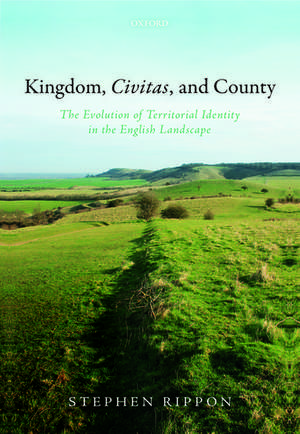Kingdom, Civitas, and County: The Evolution of Territorial Identity in the English Landscape
Autor Stephen Ripponen Limba Engleză Hardback – 19 apr 2018
Preț: 783.51 lei
Preț vechi: 1055.07 lei
-26% Nou
Puncte Express: 1175
Preț estimativ în valută:
149.97€ • 162.96$ • 126.06£
149.97€ • 162.96$ • 126.06£
Carte tipărită la comandă
Livrare economică 10-16 aprilie
Preluare comenzi: 021 569.72.76
Specificații
ISBN-13: 9780198759379
ISBN-10: 0198759371
Pagini: 464
Dimensiuni: 178 x 250 x 29 mm
Greutate: 1.06 kg
Editura: OUP OXFORD
Colecția OUP Oxford
Locul publicării:Oxford, United Kingdom
ISBN-10: 0198759371
Pagini: 464
Dimensiuni: 178 x 250 x 29 mm
Greutate: 1.06 kg
Editura: OUP OXFORD
Colecția OUP Oxford
Locul publicării:Oxford, United Kingdom
Recenzii
[A]mbitious undertaking
...the book is produced to a very high standard, the GIS-generated mapping being particularly clear and accomplished...Overall, I'd heartily recommend this book as an impressive illustration of the power of 'Big Data' to generate sophisticated and regionallynuanced narratives of the making of the English landscape.
The ambition of this important study is to trace the degree of continuity between Iron-Age tribal territories, Roman civitates and early Anglo-Saxon kingdoms ... It is now up to scholars of other regions to build upon this excellent work.
Stephen Rippon's recent book is a research feat of some significance. Its strength lies in that it does not adopt the constricted view of many earlier studies set within the narrow scope of particular disciplines or time periods, perpetuating beliefs that went unquestioned for many years and can still be met today in less academic circles. The view that early British cultural traditions decayed in the wake of the Anglo-Saxon invasions, or the opposite idea that later boundaries such as the early medieval diocesan boundaries necessarily reflected those of earlier territorial groupings, are put under close scrutiny.
Underlying the work is a huge amount of data, and Stephen has done extraordinarly well to make sense of it ... In short, the book is a triumph.
...the book is produced to a very high standard, the GIS-generated mapping being particularly clear and accomplished...Overall, I'd heartily recommend this book as an impressive illustration of the power of 'Big Data' to generate sophisticated and regionallynuanced narratives of the making of the English landscape.
The ambition of this important study is to trace the degree of continuity between Iron-Age tribal territories, Roman civitates and early Anglo-Saxon kingdoms ... It is now up to scholars of other regions to build upon this excellent work.
Stephen Rippon's recent book is a research feat of some significance. Its strength lies in that it does not adopt the constricted view of many earlier studies set within the narrow scope of particular disciplines or time periods, perpetuating beliefs that went unquestioned for many years and can still be met today in less academic circles. The view that early British cultural traditions decayed in the wake of the Anglo-Saxon invasions, or the opposite idea that later boundaries such as the early medieval diocesan boundaries necessarily reflected those of earlier territorial groupings, are put under close scrutiny.
Underlying the work is a huge amount of data, and Stephen has done extraordinarly well to make sense of it ... In short, the book is a triumph.
Notă biografică
Stephen Rippon is Professor of Landscape Archaeology at the University of Exeter with strongly interdisciplinary research interests in the landscapes of Roman and medieval Britain, regional variation in landscape character, and using the techniques of historic landscape analysis to explore how the countryside of today has come into being. He is a recent Dean of Graduate Research at the University of Exeter, and past president of the Medieval Settlement Research Group and Treasurer of the Society for Medieval Archaeology.
